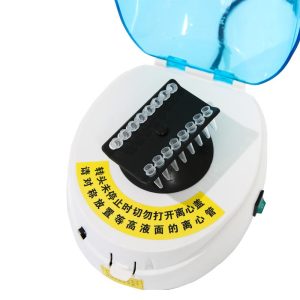Centrifuge type and precautions for use
A centrifuge is a commonly used laboratory equipment for separating solid particles or liquid components in a mixture.
Centrifuges can be classified into various types depending on their structure and working principle. Common centrifuges include:
Desktop centrifuges: Desktop centrifuges are usually smaller and suitable for small sample processing and routine laboratory work.
Large capacity centrifuge: Large capacity centrifuge has a large centrifugal capacity, suitable for handling large sample volume or high-speed centrifugal separation.
Microcentrifuges: Microcentrifuges are suitable for handling microsamples and usually have a smaller centrifuge capacity and a higher speed.
Ultracentrifuges: Ultracentrifuges can achieve higher centrifugal speed and greater centrifugal force, and are suitable for handling samples with special needs.
Cryogenic centrifuges: Cryogenic centrifuges have cooling systems that allow centrifugal separation at low temperatures and are suitable for applications that are sensitive to sample temperature.
Transparent centrifuge: The centrifugal chamber of transparent centrifuge is made of transparent material, which can observe the centrifugal process of samples in real time.

The following precautions should be taken when using a centrifuge:
Safe operation: Before using the centrifuge, ensure that the instrument is in a stable state and operate in accordance with the operation manual and safety procedures. Avoid exceeding the maximum capacity and speed limit of the centrifuge to avoid safety accidents.
Sample balance: In order to maintain the balance of the centrifuge, the sample should be placed evenly in the centrifuge rotor and ensure that the sample volume and quality within each centrifuge tube are similar.
Rotor selection: according to the sample properties and centrifugal requirements, select the appropriate centrifugal rotor. Different rotors are suitable for different centrifugal capacity and centrifugal force requirements.
Centrifuge type and precautions for use
Temperature control: For samples that need to be kept low temperature, use a cryogenic centrifuge with a cooling system, or use a cooling device to cool the centrifuge.
Cleaning and maintenance: clean centrifuge interior and rotor regularly to avoid contamination and cross-contamination. Be careful not to use solvents or cleaners that damage the surface of the centrifuge.
Uniform acceleration and deceleration: avoid sudden acceleration or deceleration to prevent spillage of the sample or rupture of the centrifuge tube.
Observe the centrifuge results: After centrifugation, pay attention to observe the separation of samples in the centrifuge tube to avoid misreading or wrong interpretation of the centrifuge results.
Remember: when using the centrifuge, read and follow the relevant operation manual and safety guide carefully to ensure safe operation and accurate experimental results.
